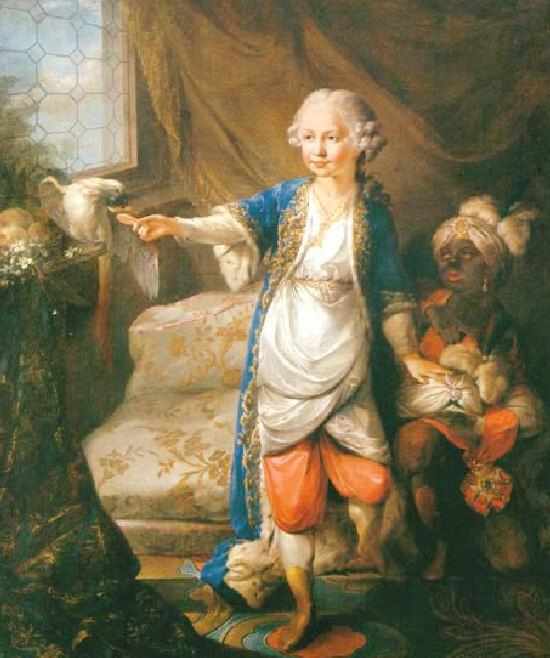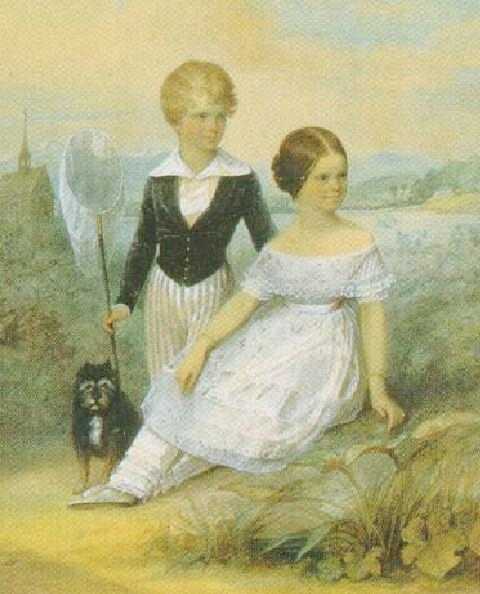

Bavarian Royalty: Kurfürst Max IV Joseph/King Maximilian I Joseph (1799-1825)

Figure 1.--Prince Maximllian Joseph is shown in a casual pose in this 1763 portrait. He was about 7 years old at the time. I'm not sure precisely what he was wearing. He appears to have had a black boy as a personal servant. I'm not sure who the artist was. A reader suggests that this was an imsginative portrait and the young prince did not have an Sfrican boy servant. Here we simply do not know.
|
|
Kurfürst Max IV Joseph, a distant cousin of Kurfürst Karl Theodor, succeeded to the throne. He was elevated in 1806 to King
Maximilian I Joseph by Napoleon through the treaty of Pressburg, , in thanks for Bavaria's joining the French cause. Bavaria
was now a kingdom for the first time in its history. The king, formerly the Elector Maximilian I Joseph, assisted Napoleon in his
wars, and in return received large additions of territory. In 1813, however, Maximilian contrived to change sides opportunely,
and thus managed to have confirmed to him, by the treaties of 1814-15, an extent of territory nearly as valuable as the
possessions which he had gained as an ally of Napoleon, and which he had now to restoreto Austria. A new constitution was granted in 1818 which restablished the the authority of the Crown. Max Joseph arranged a grand festival in 1810 to mark the wedding of his son, crown prince Ludwig, to Therese Charlotte Luise, Princess of Saxony-Hildburghausen. This was
the first Oktoberfest. Another son is noted for a daughter, the Princess Elizabeth, a future Queen of Belgium.
Parents
Kurfürst Max IV Joseph, a distant cousin of Kurfürst Karl Theodor, succeeded to the throne in 1799.
Father
Max Joseph's father was Frederick von Zweibrücken-Birkenfeld, , Count Palatine (1724- ). His parents were Christian III Zweibrücken-Birkenfeld, Duke of Zweibrücken (1674- ). His mother was
Caroline von Nassau-Saarbrücken (1704- ).
Mother
His mother was Mary Frances von Sulzbach (1724- ). She was the daughter of Joseph Charles von Sulzbach, Count Palatine (1694- ) and
Elizabeth Augusta Wittelsburg (1693- ).
Childhood
Max Joseph was born during 1756 in Mannheim, Germany. We have no information on his childhood at this time.
Childhood Clothes
Napoleonic Wars
Maximilian was elevated in 1806 to King Maximilian I Joseph by Napoleon through the Treaty of Pressburg, in return for Bavaria's joining the French cause. The Treaty of Pressburg made Bavaria one of the chief members of Napoleon's Confederation of the Rhine. Bavaria was now a kingdom for the first time in its history. The king, formerly the Elector Maximilian I Joseph, assisted Napoleon in his wars, and in return received large additions of territory. After Napoleon's disastrous invsion of Russia in 1812, Max Joseph contrived to change sides. Maximilian astutely assessed the European power situation during the Napoleonic Wars. He supported Napoleon during his accendency, but switched sides after Napoleon's Grand Army was destroyed in Russia. He joined the coalition against Napoleon a few days before the battle of Leipzig in 1813. This allowed him to enjoy the victory celebrations. As a result, Bavaria had not been devestated by the Napoleonic Wars as was Austria and other German statres. He adroitly managed to have his kingship confirmed by the Congress of Vienna treaties of 1814-15, as well as the important territories Bavaria had gained as an ally of Napoleon. He had to, however, restore territory gained from Austria.
The Church
The Napoleonic Wars had a huge impact on European institutions. One of these was the Catholic Church. The French Revolution had celebrated Reason of man over the Faith of the Church. As the Church supported the Ancien Regime, it became a target for the victorious revolutionaries. Napoleon after he seied control of the Revolution, continued this apparoch. He suppressed monastic orders and confiscating Church properties in the wake of his victorious armies. In Germany he distributed confiscated church prooerties to the secular rulers who came over to his side. One of these was Duke Maximillian who Napoleon had elevated to a king. After Napoleon's fall, King Maximillian had to make his peace with the Church. He chose a Benedictine tutor for his son Ludwig who helped create a close bond with the Benedictine Order. King Maximilian I reestablished the Catholic Church in Bavaria. The new Bavarian constitution, however, gave the state the right to both supervise Church activities and to approve church appointments. [Toltzmann, p. 16]
German Unification
Max Joseph was devoted to Bavarian independence, he opposed all efforts aimed a German unification.
New Constitution
Max Joseph worked closely with his minister, Maximilian von Montgelas to implement major social reforms in Bavaria. He abolished most of remaining the relics of the feudal system. Max Joseph in 1818 granted a liberal constitution, one of the first in Europe. This was a major steps as neigboring states like Prussia, Austria, and France in response to the excesses of the French Revolution were pursuing conservative, often reactionary, policies aimed at restoring monarchial absolutism.

Figure 2.--This painting is Elisabeth "Sissi" (Wittelsbach) and her younger brother Karl Theodor "Gackel". It looks to have been done about 1847. I'm not sure who the artist is. They were grandchildren of Max Joseph I, children of his daughter Ludovica. Elizabeth married Franz Josef and became the Austrian Emperess. Karl Teodor was the father of Elisabeth, future Queen of Belgium. Notice Elisabeth's long pantlettes, still very popular in the 1840s.
|
|
First Marriage
Wife
Max Joseph married Augusta Wilhelmine of Hesse-Darmstadt in 1785. Her father was Georg Wilhelm of Hessen-Darmstadt (1722- ) and Maria Luise Albertine of Leiningen-Dagsburg-Falkenburg (1729- ). Augusta Wilhelmine died in 1796.
Children
Max Joseph and Augusta Wilhelmine had five children. The eldest son was Ludwig I (1786-68) who became king, but abdicated in 1848. The other children were: Princess Auguste (1788- ), Amelia (1790- ), Charlotte (1792- ), and Charles (1795- ). A daughter married Napoleon’s stepson, Eugène de Beauharnais.
Second Marriage
Wife
Max Joseph married Catharine of Baden Zähringen in 1797. Her father was Karl Ludwig of Baden (1755- ). Her mother was Amalie Friederike of Hessen-Darmstadt (1754- )
Max Joseph has seven more children with Catharine: Maximilian (1800- ), Elizabeth of Bavaria (twin, 1801- ), Amelia (twin, 1801- ), Maria (twin, 1805), Sophie (twin, 1805- ), Ludovica/Louise (1808- ), and Maximiliana (1810- ). Elizabeth married King Friedrich Wilhelm IV (1795- ).
Ludovica married Duke Maximilian Joseph (1808- ) Their third child, Elizabeth (1837- ) known as Sissi , married Franz Josef and became the Emperess of Austria.
Their fourth child was Karl Theodor "Gackel" (1839-1909). He married Maria Josepha de Bragança of Portugal in 1874. They had two children: Elisabeth (1876- ) and Maria Gabriele (1878- ). Elisabeth became the Belgian Queen after marrying Prince Albert.
Children's Education
Catholcism continued to be important in Bavaia. Joseph Anton Sambuga, a deeply-religious priest, was engaged by Max Joseph to his court at Mannheim to teacher religion to Prince Ludwig. When Max Joseph went to Munich as Elector of Bavaria and aftr 1805 King, Sambuga remained with the court and taught religion to the younger children.
Children's Clothes
We have no details on the children's clothes. The image here of Max Joseph's grand children provides some indication of how they were dessed in the late 1840s. Karl Teodor wear a short jacket and stripped long pants. Elisabeth wears a white dress knee with a low-neckline and very long pantalettes.
Octoberfest
In 1810 Max Joseph arranged a grand festival to
mark the wedding of his son, crown prince Ludwig, to Therese Charlotte Luise, Princess of Saxony-Hildburghausen. This was
the first Oktoberfest.
Sources
Toltzmann, Don Heinrich. "Understanding the Causes of the German Immigrations: The Context of German History before 1830," The Ohio Valley, New German-American Studies, 4, (New York: Peter Lang, 1993).
HBRC

Navigate the Boys' Historical Clothing Web Site royal pages:
[Main Bavarian royal page]
[Main royal pages]
[Austria]
[Belgium]
[Denmark]
[France]
[German Empire]
[German States]
[Italy]
[Luxenburg]
[Monaco]
[Netherlands]
[Norway]
[Romania]
[Russia]
[Spain]
[United Kingdom]
Created: May 6, 2002
Last updated: 9:31 AM 3/13/2011





